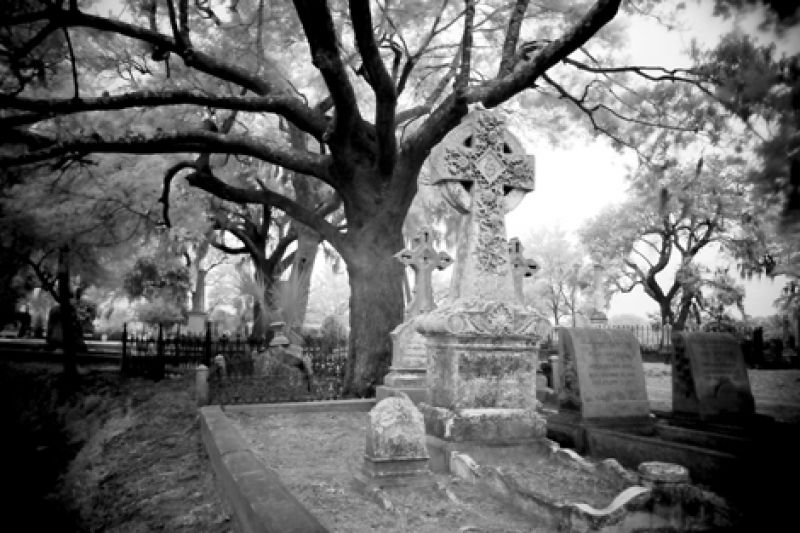
I confess to being one of those odd sorts who digs graveyards. Not literally, of course, but I do find solace and a gentle intrigue amidst those who have passed this way before. My husband considers this loony (not comforting, as he’s a psychiatrist); he prefers to keep company with those who have an open-ended dash dangling after the year of their birth. But there is something about the “groundedness” of a cemetery, the hushed beauty of headstones and silent eloquence of epitaphs, that draws me to them. Needless to say, I am a happy wanderer here amidst the Holy City’s ubiquitous churchyards, her bounty of the dead and buried.
I love riding my bike up East Bay and northward to Morrison, past the tattoo parlors and The Joker, through the Neck’s still-rough industrial detritus, and then detouring into the hallowed wonderland of sculpted angels and obelisks that is Magnolia Cemetery. Marble headstones and small monuments bear monumental South Carolina names: William Aiken, Arthur Middleton Manigault, John Bennett, Horace Hunley—the submarine inventor—as well as the valiant crews who died in his invention. Here lie governors, senators, artists, poets, writers, and some 2,200 Confederate soldiers. Here, between aging stones with names both famous and forgotten, a deep history whispers. Spanish moss moseys in the breeze; squirrels dash about busy with the chase of living; herons meditate; and a congregation of crooked-beaked ibis peck around, paying their respects.
I appreciate the careful tending and fastidiousness of St. Philips’ churchyard—the blatant homage to status and lineage that its stately markers convey. I also love how the enchantingly wild unruliness of the Unitarian cemetery a few blocks over is the perfect juxtaposition—differing theologies framed by tamed azaleas in one and rampant wisteria in the other, yet the inhabitants of both now equally silent, no longer debating the finer points of sin and redemption. To meander through Charleston’s cemeteries is to wander through her centuries. Time becomes clustered into small mounds of turned earth, long settled, a chronology of listing markers and crumbling slate. I recite the poetry of names—Zadok Jesup, Octavia Bart, Eliza Lucilla “Relict of the Late R. Dewar Simons.” I trace my hand along engraved portraits of a child’s head with angel wings; I squint my eyes at the collage of lime green and brown lichen that has transformed the now illegible headstone of John Fullerton into funky abstract art. I conjure stories, imagining how Mrs. Martha Simmons walked home with the hem of her swishy, itchy long skirt dragging along the city’s dirt streets and how then she ate oyster stew to ease the pain of losing two sons to consumption in 1850 and 1851.
On Sundays, I go to church passing through the city’s oldest burial yard, Circular Congregational’s chessboard of gravestones that have endured war, earthquake, and the pressures of exorbitant commercial real estate to give testimony to their namesakes. On most Sundays, this is spiritual nurture enough, a sermon in earth and rock, silent hymns to life’s brevity. My girls have grown up celebrating Easter morning with an egg hunt among these ancient tombstones. A tooth-and-nail tussle for plastic eggs stuffed with Jolly Ranchers and jellybeans and hidden among the markers, including the one where “lies interred Mary Owen, Relict of Richard Owen / She adored the Christian religion, and in every station of her life / seen of exemplary Piety” and who no doubt would be rolling in her grave at this impious egg scramble.
But my distinctly unexemplary piety makes me certain that playing in the churchyard is entirely appropriate. For it is here, in this resting place—on ground leveled with sorrow; tended with care; and walked on by those bearing hope, despair, and unanswerable questions—that my spirit gets restless. Here lie reminders that a deadline looms, that I must get on with creating, constructing, or contributing whatever it is I am here to do. I pause before the gravestone of Susan Branford (1834–1895), where a blue jay’s demise (lunch for the feral churchyard cats) is evidenced by scattered feathers the color of bright blue marbles. On her stone—beneath the gracefully choreographed script that says “Sacred to the Memory” with a big frilly “S”—is this epitaph: “We close our eyes to the decaying world, till Angels bid us rise.” True enough, dear Susan, but the angels also nudge me here and now, in Charleston’s graveyards, where my eyes are ever opened to this precious decaying world.
 Charleston contributing editor Stephanie Hunt has lived in Mount Pleasant for the last 20 years and has come to love the Lowcountry’s living folks, in addition to its dearly departed.
Charleston contributing editor Stephanie Hunt has lived in Mount Pleasant for the last 20 years and has come to love the Lowcountry’s living folks, in addition to its dearly departed.